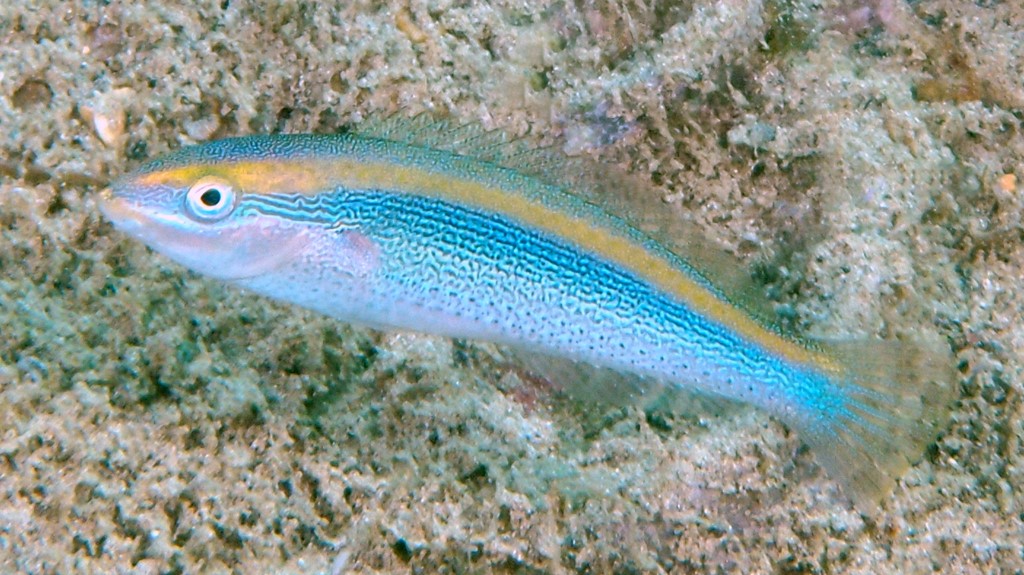STETHOJULIS NOTIALIS - (RANDALL, 2000)
Actinopterygii (Gigaclass) > Actinopteri (Class) > Teleostei (Subclass) > Labriformes (Order) > Labroidei (Suborder) > Labridae (Family) > Stethojulis (Genus)
Labre Fidjien, Fiji Wrasse, Southern wrasse,
Description
Dorsal spines (total): 9; Dorsal soft rays (total): 11-12 (usually: 11); Anal spines: 3; Anal soft rays: 11; Pectoral fin rays: 13-14. Max. length: 7.4 cm SL. Gill rakers: 22-26. Depth range: 0 - 6 m.
Color
Initial phase: with a distinct sone of irregular dark longitudinal lines in middle of body below lateral line, the body above pale (yellow in life, extending as a stripe from font of snout to upper base of caudal fin); Initial phase without a horizontal black line from upper edge of pectoral fin base to beneath pectoral fin.
Terminal male phase: with 4 distinct black bars (often a faint fifth one) on midside of body, not conjoined dorsally.
Etymology
Stethojulis: from Greek, stetho, stethion = brest or chest + from Greek, julis, original genus of several species Günther moved to Stethojulis. Referring to thoracic scales as large as, or larger, than those on sides.
notialis: from Greek, notos = southern. Referring to its occurrence in the southwestern Pacific.
Original description: Stethojulis notialis Randall, 2000 - Locality type: Suva Bay, Nukulau Island, southwestern corner of island, small bay, Viti Levu, Fiji, 18°10'23"S, 178°31'19"E, South Pacific, depth: 0-1 m.
Distribution
Southwestern Pacific: Grande Terre Group (New Caledonia), Norfolk Island, Fiji, Tonga, Samoa.
Biology
This species is demersal and inhabits flats with patchy reefs. It occurs in small groups over algal rubble on semi-open substrate. One of the most maneuverable and rapid swimmers of the Labridae, using rapid beats of the pectoral fins for propulsion.
Similar species
Stethojulis interrupta (Bleeker, 1851) - Reported from Red Sea; Indo-West Pacific: Eastern Cape and KwaZulu-Natal (South Africa), East Africa, Persian Gulf, Socotra (Yemen, Seychelles), Madagascar, Saint Brandon's Shoals (Cargados Carajos) and Mascarenes (Mauritius), east to Philippines, New Ireland (Papua New Guinea) and Solomon Islands, north to southern Japan, south to Rottnest Island (Western Australia) and Montague Island (New South Wales, Australia).
Stethojulis maculata (Schmidt, 1931) - Reported from Western Pacific: Japan; Palawan (Philippines); Fiji. Male terminal phase ressemble Stethojulis notialis.
Stethojulis terina (Jordan & Snyder, 1902) - Reported from Northwestern Pacific.
Last update: 4, May 2023
Labre Fidjien, Fiji Wrasse, Southern wrasse,
Description
Dorsal spines (total): 9; Dorsal soft rays (total): 11-12 (usually: 11); Anal spines: 3; Anal soft rays: 11; Pectoral fin rays: 13-14. Max. length: 7.4 cm SL. Gill rakers: 22-26. Depth range: 0 - 6 m.
Color
Initial phase: with a distinct sone of irregular dark longitudinal lines in middle of body below lateral line, the body above pale (yellow in life, extending as a stripe from font of snout to upper base of caudal fin); Initial phase without a horizontal black line from upper edge of pectoral fin base to beneath pectoral fin.
Terminal male phase: with 4 distinct black bars (often a faint fifth one) on midside of body, not conjoined dorsally.
Etymology
Stethojulis: from Greek, stetho, stethion = brest or chest + from Greek, julis, original genus of several species Günther moved to Stethojulis. Referring to thoracic scales as large as, or larger, than those on sides.
notialis: from Greek, notos = southern. Referring to its occurrence in the southwestern Pacific.
Original description: Stethojulis notialis Randall, 2000 - Locality type: Suva Bay, Nukulau Island, southwestern corner of island, small bay, Viti Levu, Fiji, 18°10'23"S, 178°31'19"E, South Pacific, depth: 0-1 m.
Distribution
Southwestern Pacific: Grande Terre Group (New Caledonia), Norfolk Island, Fiji, Tonga, Samoa.
Biology
This species is demersal and inhabits flats with patchy reefs. It occurs in small groups over algal rubble on semi-open substrate. One of the most maneuverable and rapid swimmers of the Labridae, using rapid beats of the pectoral fins for propulsion.
Similar species
Stethojulis interrupta (Bleeker, 1851) - Reported from Red Sea; Indo-West Pacific: Eastern Cape and KwaZulu-Natal (South Africa), East Africa, Persian Gulf, Socotra (Yemen, Seychelles), Madagascar, Saint Brandon's Shoals (Cargados Carajos) and Mascarenes (Mauritius), east to Philippines, New Ireland (Papua New Guinea) and Solomon Islands, north to southern Japan, south to Rottnest Island (Western Australia) and Montague Island (New South Wales, Australia).
Stethojulis maculata (Schmidt, 1931) - Reported from Western Pacific: Japan; Palawan (Philippines); Fiji. Male terminal phase ressemble Stethojulis notialis.
Stethojulis terina (Jordan & Snyder, 1902) - Reported from Northwestern Pacific.
Last update: 4, May 2023
